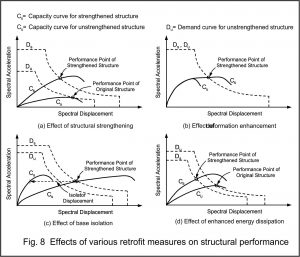Effects of Seismic Retrofitting on Structural Performance
The seismic retrofit techniques briefly presented in the preceding sections vary in the mechanisms that they decrease the seismic risk of structures. Fig. 8 graphically illustrates these mechanisms by means of their effects on the seismic demand and structural capacity curves shown in Part 2. These effects are presented in the following paragraphs at a simplified conceptual level. The typical effect of conventional strengthening methods is shown in Fig. 8(a). Conventional strengthening applications generally lead to an increase in both the stiffness and the lateral load capacity of the structure. This is shown by the capacity curve of the strengthened structure, Cs, which has a higher slope and peak compared to the capacity curve before strengthening, Cu. Due to the increased stiffness, which translates into a decreased fundamental period, the seismic demand on the structure is also increased, as shown by the demand curve for the strengthened structure, Ds,compared to that for the un strengthened structure, Du. Although the capacity increase is partly alleviated by the increase in seismic demand, the overall performance of the structure is improved as shown by the locations of the performance points on the spectral displacement axis for before and after strengthening. Increasing the overall deformation capacity of a structure is also an effective
seismic retrofitting method.
Insufficient deformation capacity of structural members is usually caused by their inadequate seismic detailing. Ductility of these members can be increased through various measures such as providing additional confinement by additional stirrups or
wrapping with FRP composites. Fig. 8(b) shows the effect of deformation or ductility enhancement on the structural performance. While the capacity curve of the structure prior to retrofitting does not intersect the demand curve, an intersection i.e. a performance point is obtained after retrofitting. It is important to note that since the stiffness and damping characteristics of the structure are not significantly altered, the demand curve remains essentially the same after retrofitting.
READ MORE
SEISMIC RETROFITTING
SEISMIC RETROFITTING TECHNIQUES
BASE ISOLATION
SUPPLEMENTAL ENERGY DISSIPATION AND ENERGY CONTROL
Effects of Seismic Retrofitting, Effects of Seismic Retrofitting, Effects of Seismic Retrofitting, Effects of Seismic Retrofitting, Effects of Seismic Retrofitting, Effects of Seismic Retrofitting, Effects of Seismic Retrofitting, Effects of Seismic Retrofitting
